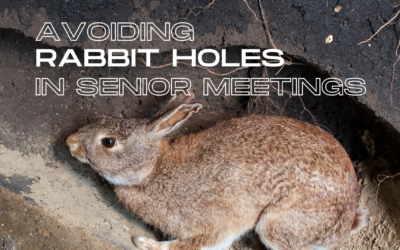Over the past two weeks I have shared two ideas to help you lift the quality of your own papers and presentations.
Today I share the third. It might seem like an odd one, but bear with me. It’s about velocity.
How quickly can you develop and deliver powerful insights that lead to fast, high-quality decisions?
In reading Colin Bryar and Bill Carr’s excellent book, Working Backwards, which describes Amazon’s secret to success many insights stood out.
The principle of velocity was one of them.
Amazon has gone to great lengths to maintain velocity in all areas of its operations so it can maintain its ability to execute quickly on innovative business lines.
Great effort is taken to remove bottlenecks and keep the teams on their ‘front foot’.
Communication is one of those areas. I see an opportunity to insert structure and discipline into the communication process just as you might any other business process.
Imagine this: Could board papers receive ‘minimal adjustments’ at each layer of your organization’s approval chain? Even better when the Board approves the idea the first time it is presented.
My client from the supply chain team at a large retailer, coined a term that I’ve borrowed: they call it the Gold Standard. Here’s how it works:
Someone prepares their highly structured one-pager either alone or with colleagues, before socialising that page with stakeholders. This triggers constructive debate around the big picture ideas and how they connect with the data. By socialising a one-page ‘message map map’ rather than a polished document at least four important things happen.
- Everyone in the process can review the message map and respond quickly with constructive suggestions to refine the thinking. One CEO client tells me he block-reviews papers and spends an average of 15 minutes on each paper. This is a marked reduction in the time he previously spent reviewing papers for the Senior Leadership Team and the Board.
- Everyone feels as though they have permission to debate the ideas. When someone receives a document that someone has obviously ‘sweated over’ they feel less comfortable about having the debate. It feels like a ‘correction’ rather than a ‘conversation’.
- The team isn’t wedded to unhelpful concepts and charts that ‘must’ remain in the document. As soon as we create a chart or write a section, we become wedded to it rather than the ideas it represents. We spend time trying to ‘fit it in’ rather than stepping back and looking at the overall message we need to convey.
- Less time is spent preparing prose and charts that turn out to be off point. Rather than focusing our energies on preparing polished drafts, we can focus on the messaging.
Once the ideas are locked in, the paper is prepared and sent up the chain for, hopefully, only minor adjustment.
In this model, teams focus on finessing ideas rather than tweaking words, fiddling with PowerPoint connectors or following a format.
This liberates you and your team from the awful game of ‘red pen ping pong’ so you can focus on higher order activities.
Our clients frequently see a 30 percent lift in velocity when drafting papers and presentations. This impacts both team members and leaders. Some teams, such as those outlined in the next section, achieve materially more than that.
Before establishing some concrete goals for you and your team let’s be inspired by what is possible.
Ask yourself: What do you need to change to get to the Gold Standard for you and your team?
I hope that helps.
Davina
PS. You can find the first two parts of this series on Communication Quality here:
RELATED POSTS
When to avoid reviewing other people's papers and presentations
Most of us review communication for colleagues....
How to be human when communicating with senior leaders
A couple of situations this week reminded me of...
How to deliver better board and SLT papers more quickly
TLDR ..... 1. Thank you for the LinkedIn...
Is your paper really for noting?
Hello Davina, TLDR .....1. Thank you for the...
How to keep your board on topic
Has this happened to you?You have an important...
How to build trust with your senior leaders
TLDR: The answer is to provide less information...

PRESENTED BY DAVINA STANLEY
I love what I do.
I help senior leaders and their teams prepare high-quality papers and presentations in a fraction of the time.
This involves 'nailing' the message that will quickly engage decision makers in the required outcome.
I leverage 25+ years' experience including
- learning structured thinking techniques at McKinsey in Hong Kong in the mid 1990s before coaching and training their teams globally as a freelancer for a further 15 years
- being approved to teach the Pyramid Principle by Barbara Minto in 2009
- helping CEOs, C-suite leaders and their reports deeply understand their stakeholder needs and communicate accordingly
- seeing leaders cut the number of times they review major papers by ~30% and teams cut the amount of time they take to prepare major papers by ~20%*
- watching senior meetings focus on substantive discussions and better decisions rather than trying to clarify the issue
My approach helps anyone who needs to engage senior leaders and Boards.
Recent clients include 7Eleven, KPMG, Mercer, Meta, Woolworths.
Learn more at www.clarityfirstprogram.com
(*) Numbers are based on 2023 client benchmarking results.








